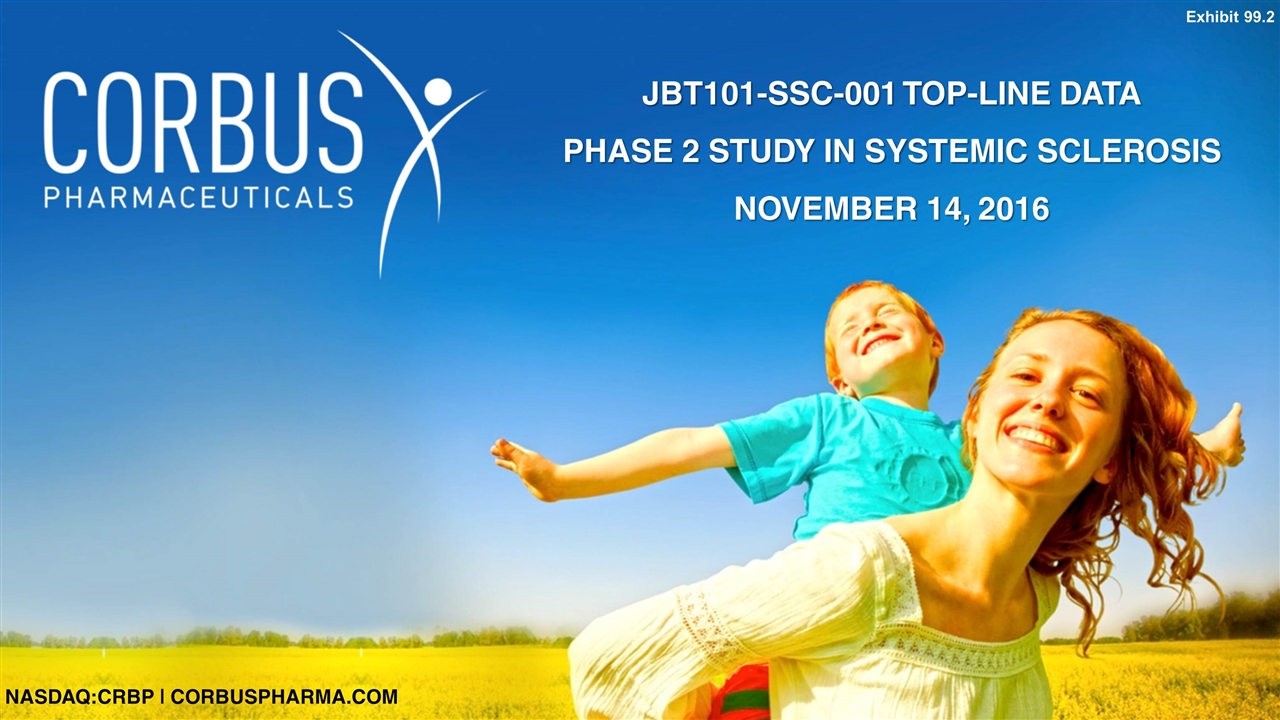
NASDAQ:CRBP | CORBUSPHARMA.COM JBT101-SSC-001 TOP-LINE DATA PHASE 2 STUDY IN SYSTEMIC SCLEROSIS NOVEMBER 14, 2016 Exhibit 99.2
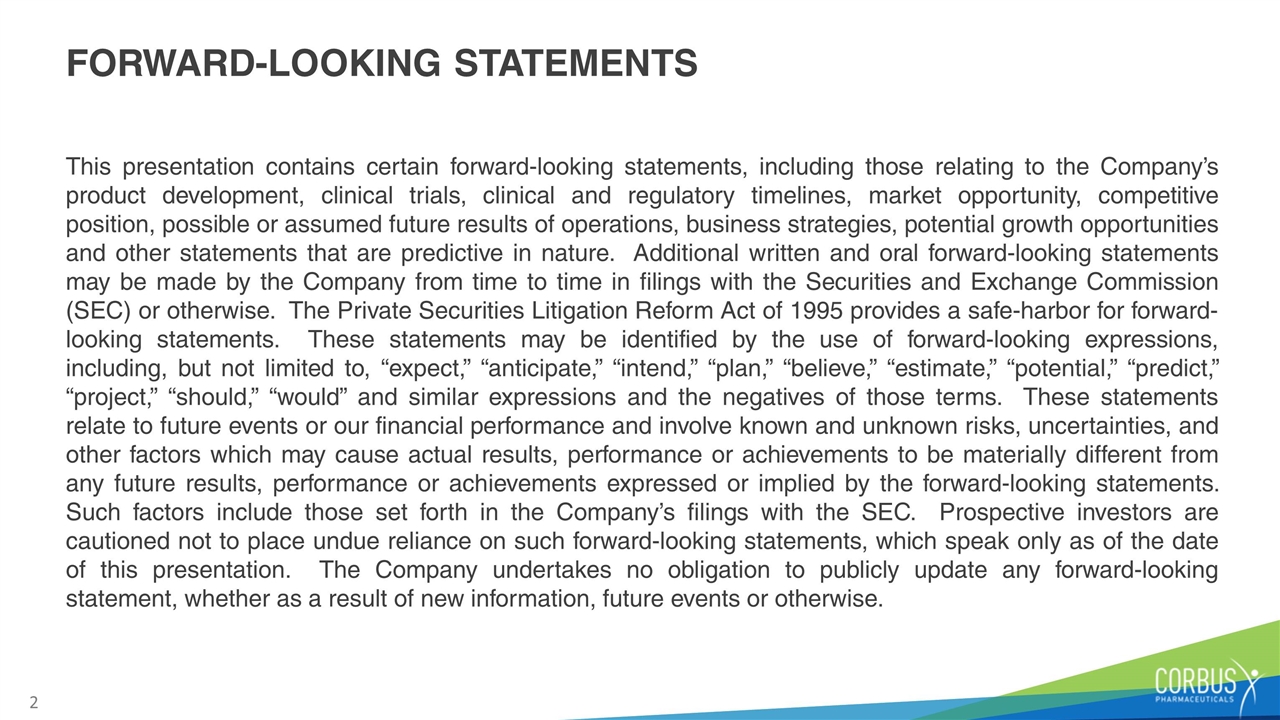
FORWARD-LOOKING STATEMENTS This presentation contains certain forward-looking statements, including those relating to the Company’s product development, clinical trials, clinical and regulatory timelines, market opportunity, competitive position, possible or assumed future results of operations, business strategies, potential growth opportunities and other statements that are predictive in nature. Additional written and oral forward-looking statements may be made by the Company from time to time in filings with the Securities and Exchange Commission (SEC) or otherwise. The Private Securities Litigation Reform Act of 1995 provides a safe-harbor for forward-looking statements. These statements may be identified by the use of forward-looking expressions, including, but not limited to, “expect,” “anticipate,” “intend,” “plan,” “believe,” “estimate,” “potential,” “predict,” “project,” “should,” “would” and similar expressions and the negatives of those terms. These statements relate to future events or our financial performance and involve known and unknown risks, uncertainties, and other factors which may cause actual results, performance or achievements to be materially different from any future results, performance or achievements expressed or implied by the forward-looking statements. Such factors include those set forth in the Company’s filings with the SEC. Prospective investors are cautioned not to place undue reliance on such forward-looking statements, which speak only as of the date of this presentation. The Company undertakes no obligation to publicly update any forward-looking statement, whether as a result of new information, future events or otherwise.
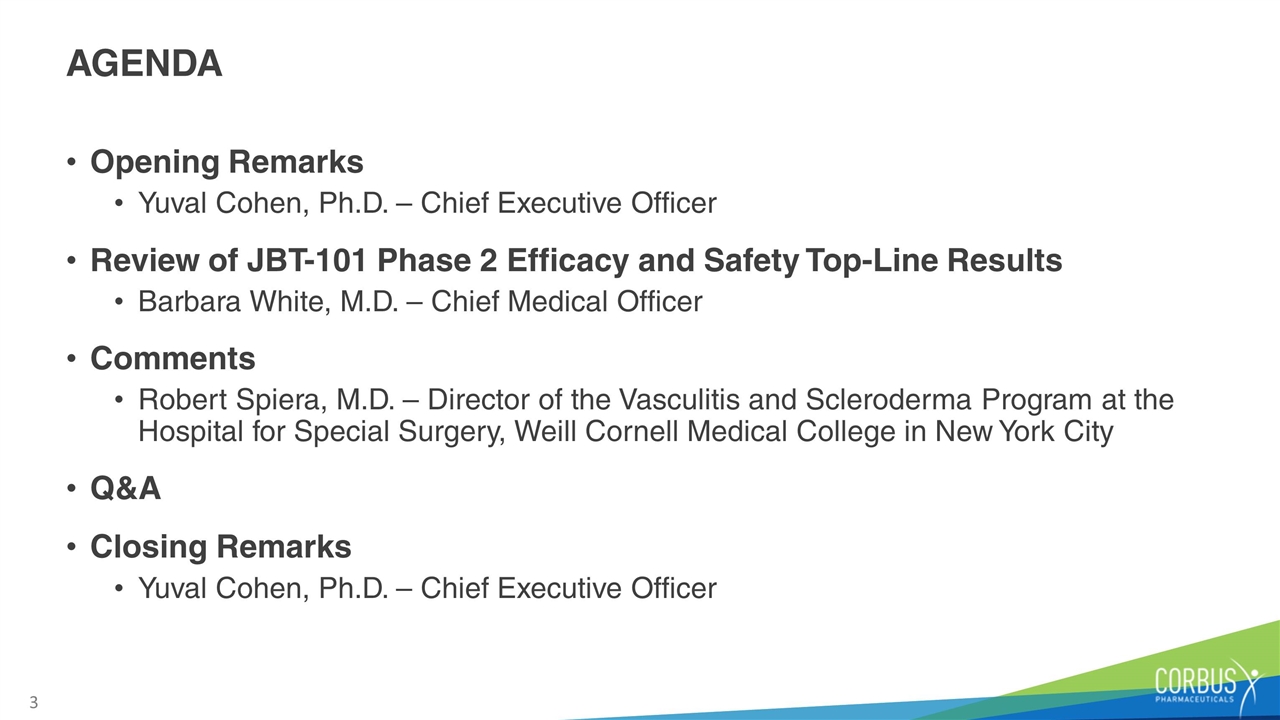
AGENDA Opening Remarks Yuval Cohen, Ph.D. – Chief Executive Officer Review of JBT-101 Phase 2 Efficacy and Safety Top-Line Results Barbara White, M.D. – Chief Medical Officer Comments Robert Spiera, M.D. – Director of the Vasculitis and Scleroderma Program at the Hospital for Special Surgery, Weill Cornell Medical College in New York City Q&A Closing Remarks Yuval Cohen, Ph.D. – Chief Executive Officer
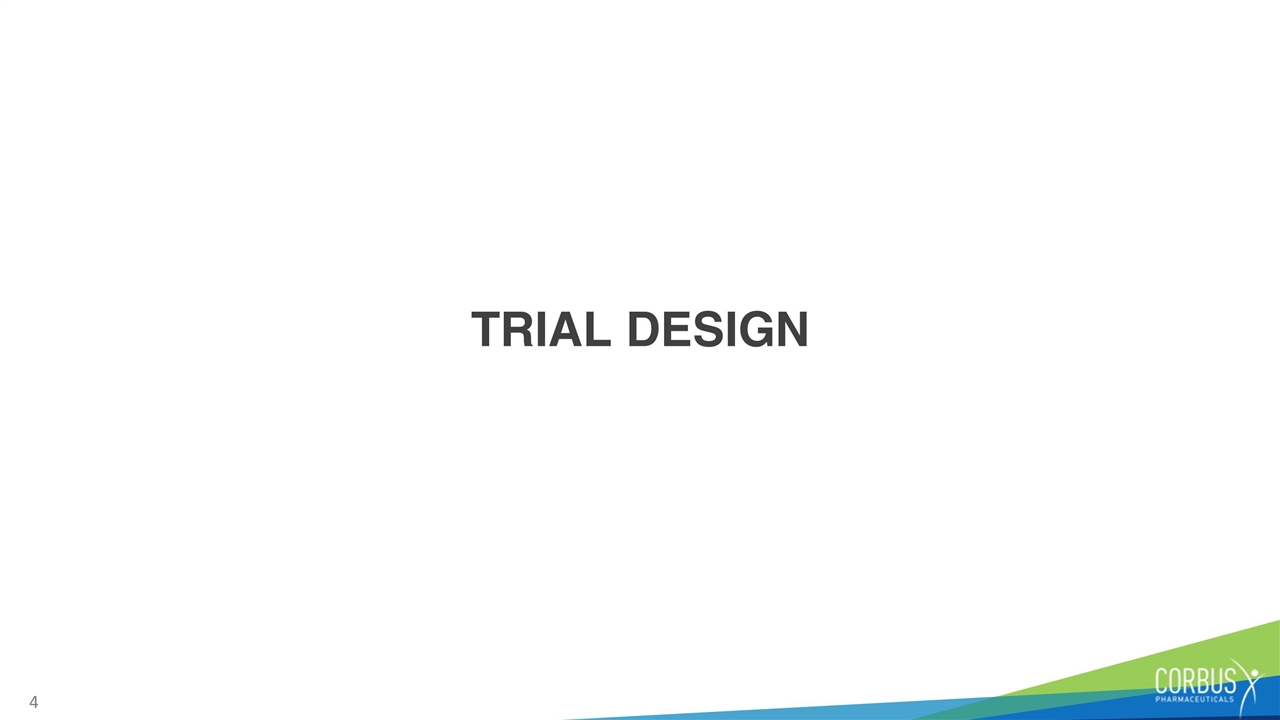
TRIAL DESIGN
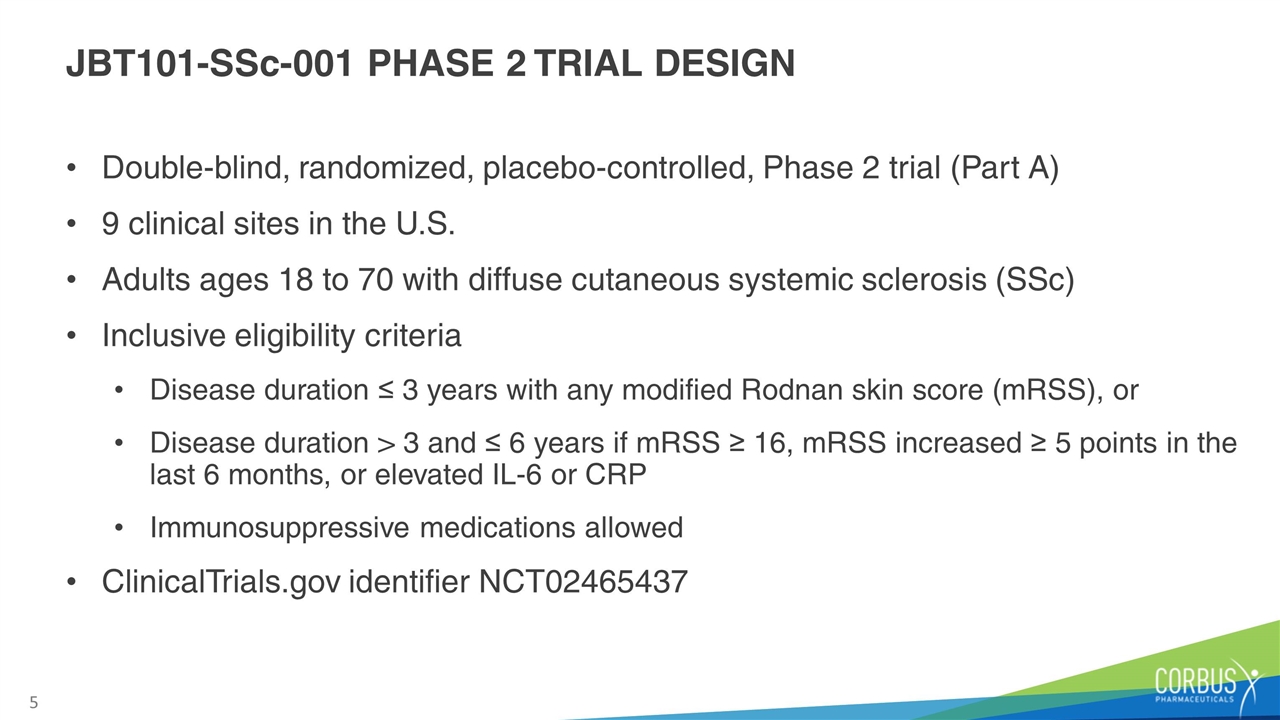
JBT101-SSc-001 PHASE 2 TRIAL DESIGN Double-blind, randomized, placebo-controlled, Phase 2 trial (Part A) 9 clinical sites in the U.S. Adults ages 18 to 70 with diffuse cutaneous systemic sclerosis (SSc) Inclusive eligibility criteria Disease duration ≤ 3 years with any modified Rodnan skin score (mRSS), or Disease duration > 3 and ≤ 6 years if mRSS ≥ 16, mRSS increased ≥ 5 points in the last 6 months, or elevated IL-6 or CRP Immunosuppressive medications allowed ClinicalTrials.gov identifier NCT02465437
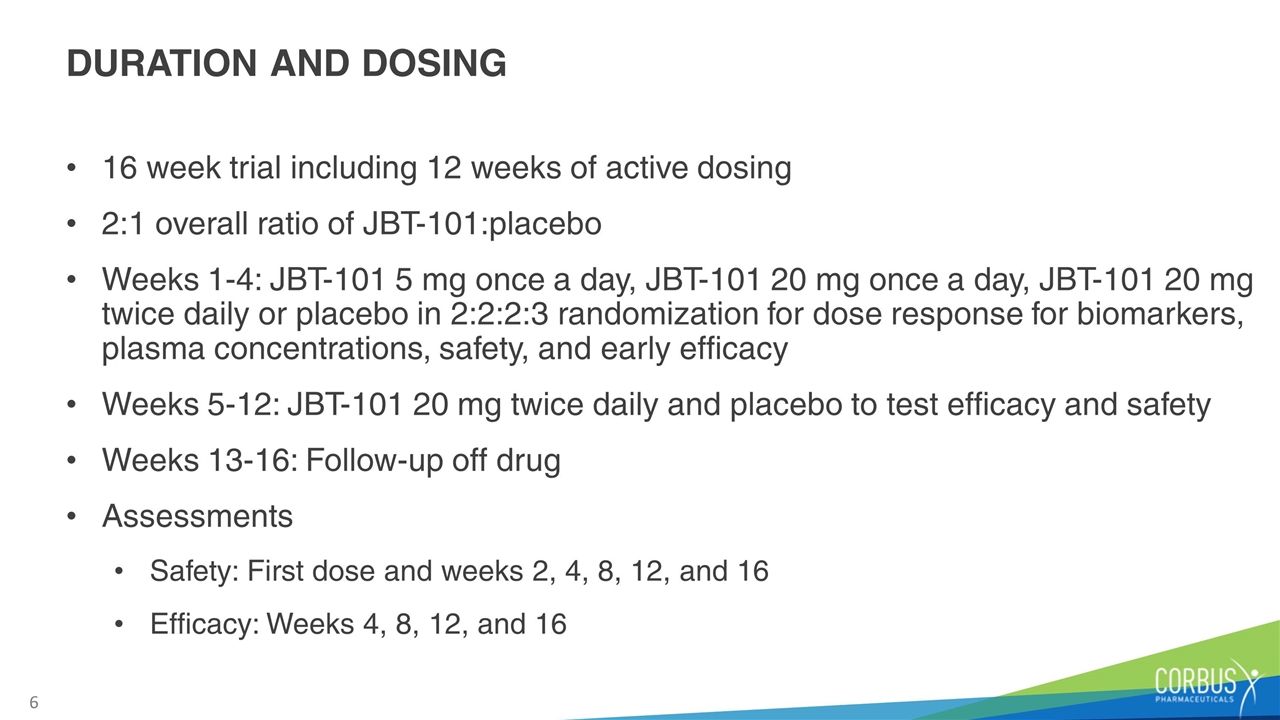
DURATION AND DOSING 16 week trial including 12 weeks of active dosing 2:1 overall ratio of JBT-101:placebo Weeks 1-4: JBT-101 5 mg once a day, JBT-101 20 mg once a day, JBT-101 20 mg twice daily or placebo in 2:2:2:3 randomization for dose response for biomarkers, plasma concentrations, safety, and early efficacy Weeks 5-12: JBT-101 20 mg twice daily and placebo to test efficacy and safety Weeks 13-16: Follow-up off drug Assessments Safety: First dose and weeks 2, 4, 8, 12, and 16 Efficacy: Weeks 4, 8, 12, and 16
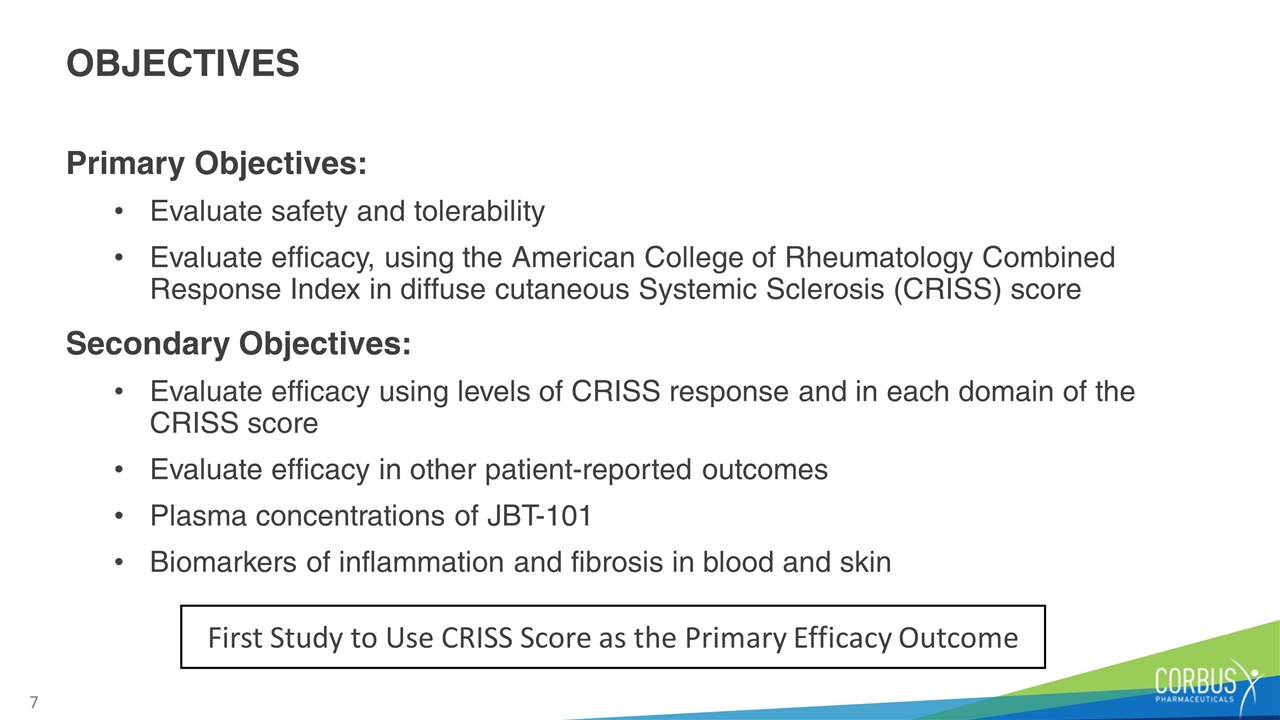
OBJECTIVES Primary Objectives: Evaluate safety and tolerability Evaluate efficacy, using the American College of Rheumatology Combined Response Index in diffuse cutaneous Systemic Sclerosis (CRISS) score Secondary Objectives: Evaluate efficacy using levels of CRISS response and in each domain of the CRISS score Evaluate efficacy in other patient-reported outcomes Plasma concentrations of JBT-101 Biomarkers of inflammation and fibrosis in blood and skin First Study to Use CRISS Score as the Primary Efficacy Outcome
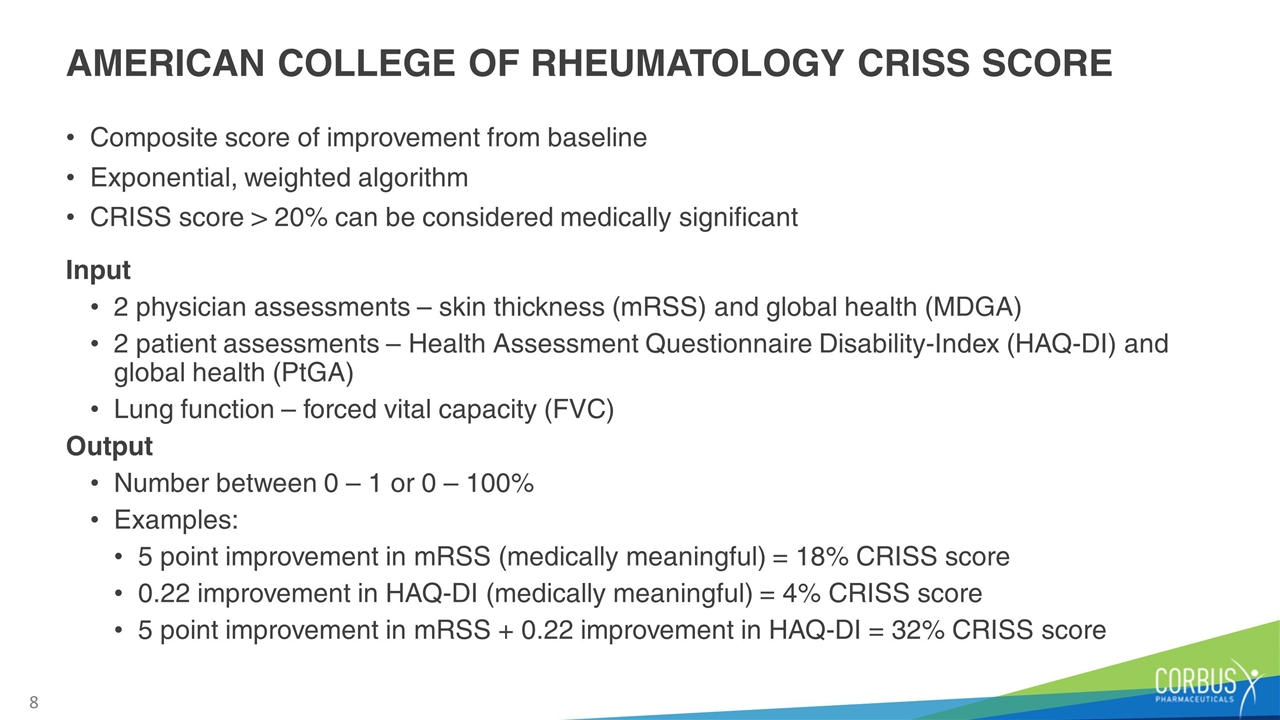
AMERICAN COLLEGE OF RHEUMATOLOGY CRISS SCORE Composite score of improvement from baseline Exponential, weighted algorithm CRISS score > 20% can be considered medically significant Input 2 physician assessments – skin thickness (mRSS) and global health (MDGA) 2 patient assessments – Health Assessment Questionnaire Disability-Index (HAQ-DI) and global health (PtGA) Lung function – forced vital capacity (FVC) Output Number between 0 – 1 or 0 – 100% Examples: 5 point improvement in mRSS (medically meaningful) = 18% CRISS score 0.22 improvement in HAQ-DI (medically meaningful) = 4% CRISS score 5 point improvement in mRSS + 0.22 improvement in HAQ-DI = 32% CRISS score
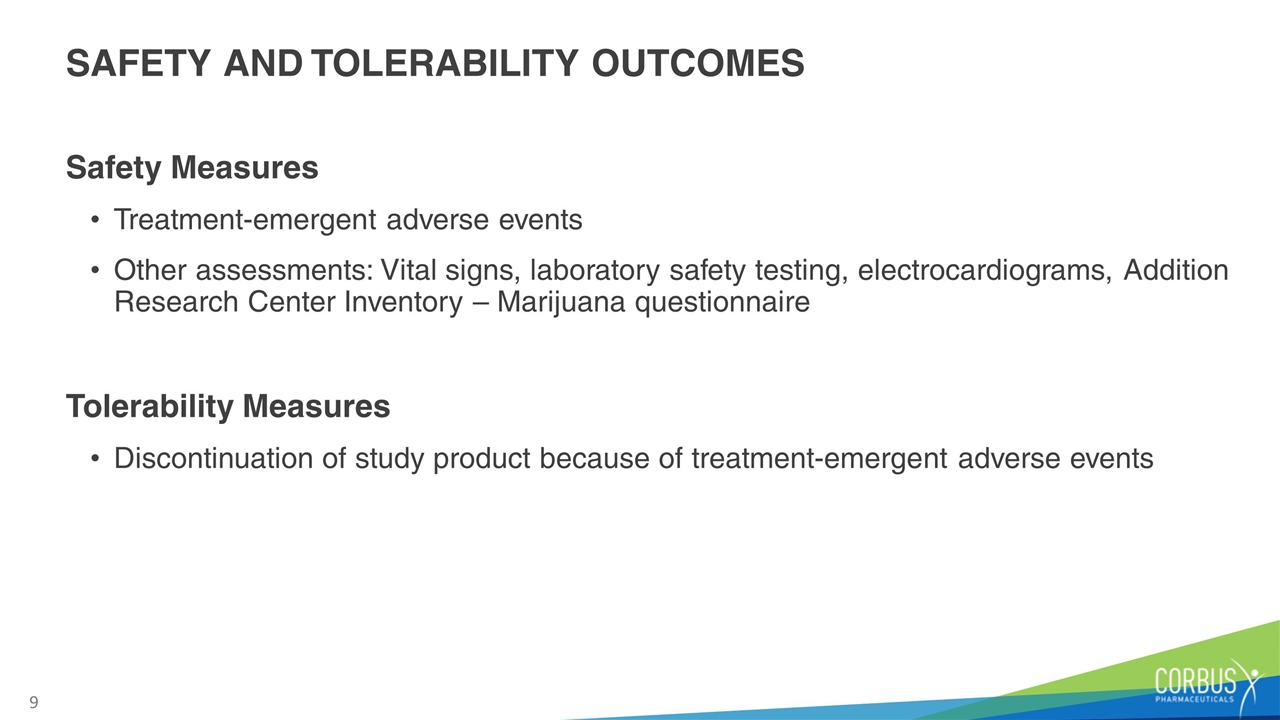
SAFETY AND TOLERABILITY OUTCOMES Safety Measures Treatment-emergent adverse events Other assessments: Vital signs, laboratory safety testing, electrocardiograms, Addition Research Center Inventory – Marijuana questionnaire Tolerability Measures Discontinuation of study product because of treatment-emergent adverse events
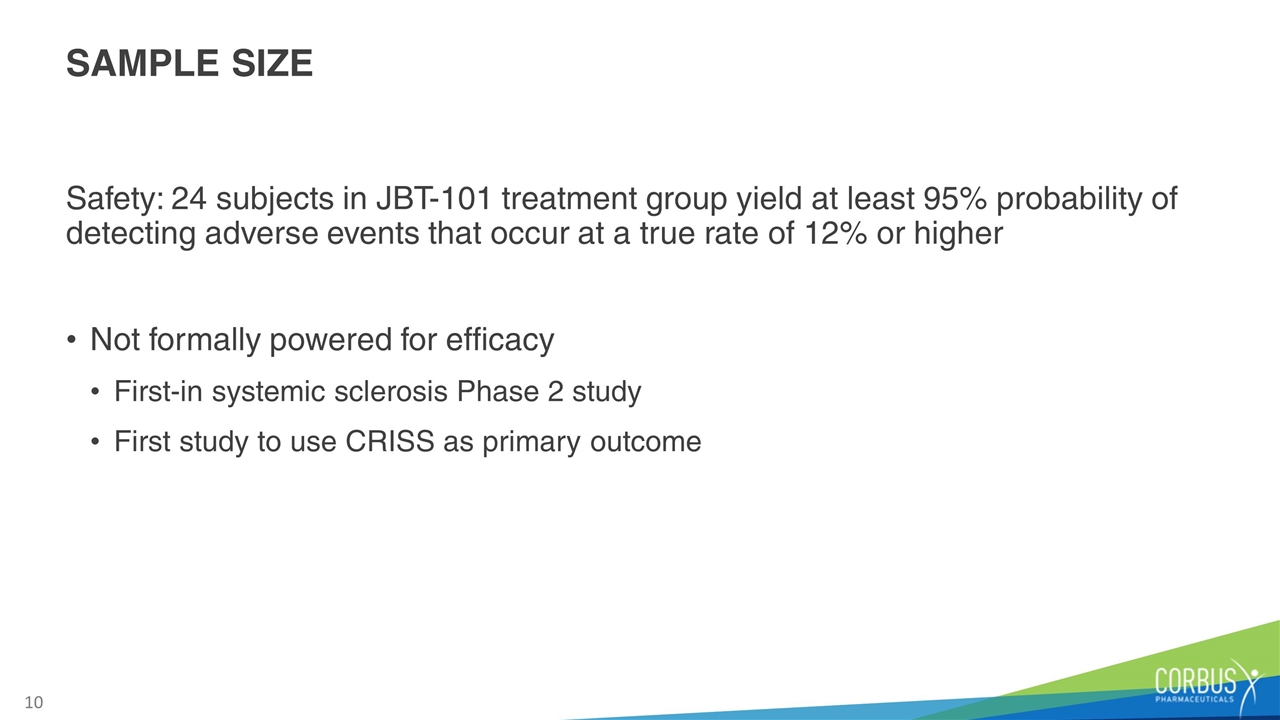
SAMPLE SIZE Safety: 24 subjects in JBT-101 treatment group yield at least 95% probability of detecting adverse events that occur at a true rate of 12% or higher Not formally powered for efficacy First-in systemic sclerosis Phase 2 study First study to use CRISS as primary outcome

SUBJECT DISPOSITION AND BASELINE CHARACTERISTICS
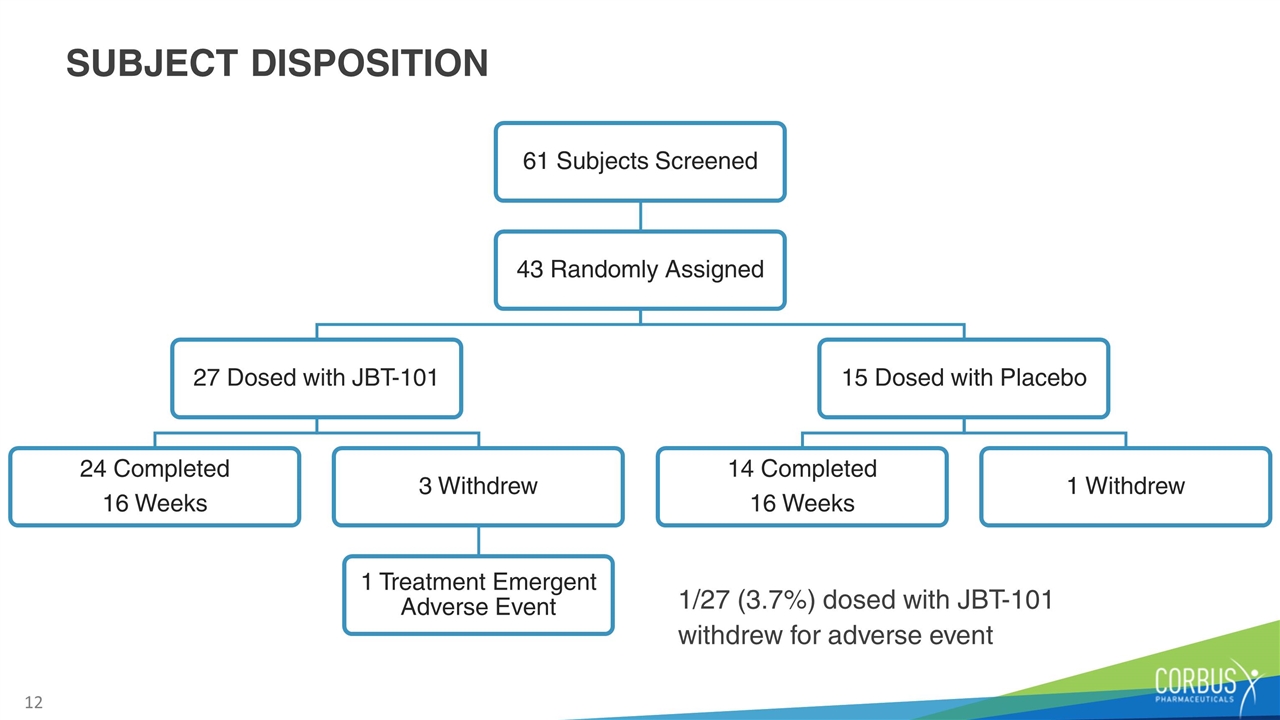
SUBJECT DISPOSITION 1/27 (3.7%) dosed with JBT-101 withdrew for adverse event 61 Subjects Screened 43 Randomly Assigned 27 Dosed with JBT-101 15 Dosed with Placebo 24 Completed 16 Weeks 3 Withdrew 14 Completed 16 Weeks 1 Withdrew 1 Treatment Emergent Adverse Event
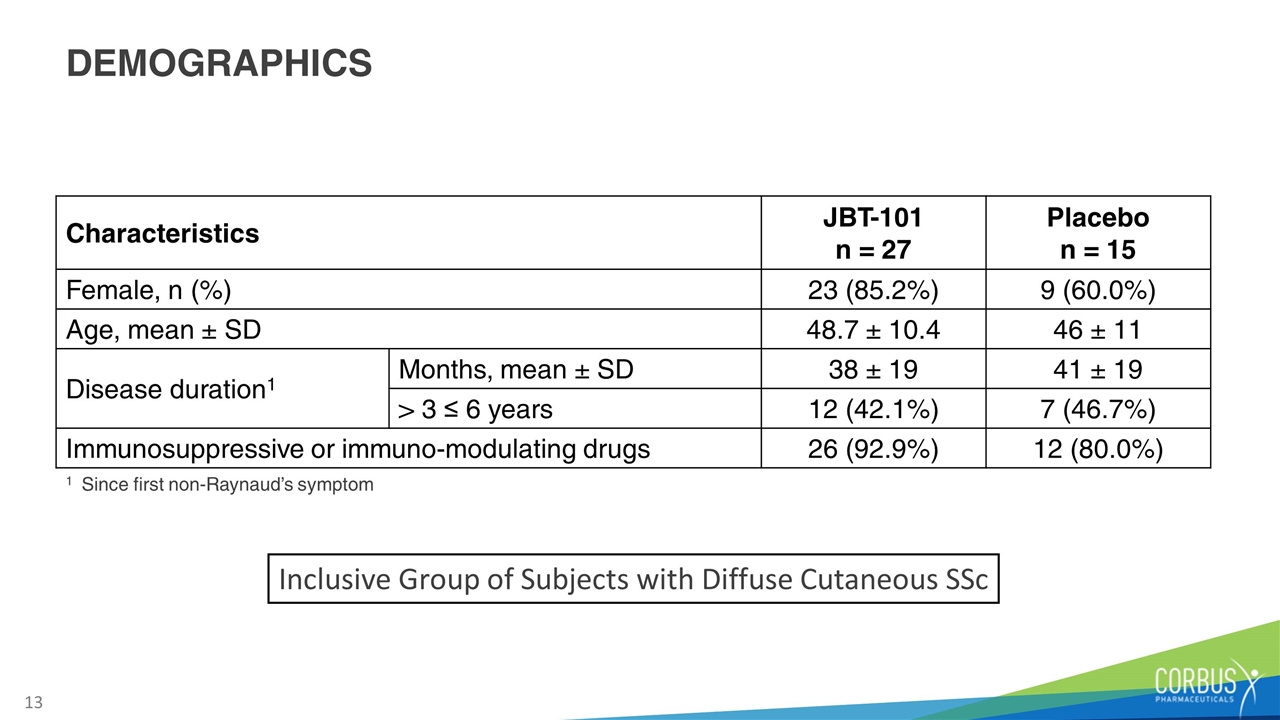
DEMOGRAPHICS Characteristics JBT-101 n = 27 Placebo n = 15 Female, n (%) 23 (85.2%) 9 (60.0%) Age, mean ± SD 48.7 ± 10.4 46 ± 11 Disease duration1 Months, mean ± SD 38 ± 19 41 ± 19 > 3 ≤ 6 years 12 (42.1%) 7 (46.7%) Immunosuppressive or immuno-modulating drugs 26 (92.9%) 12 (80.0%) 1 Since first non-Raynaud’s symptom Inclusive Group of Subjects with Diffuse Cutaneous SSc
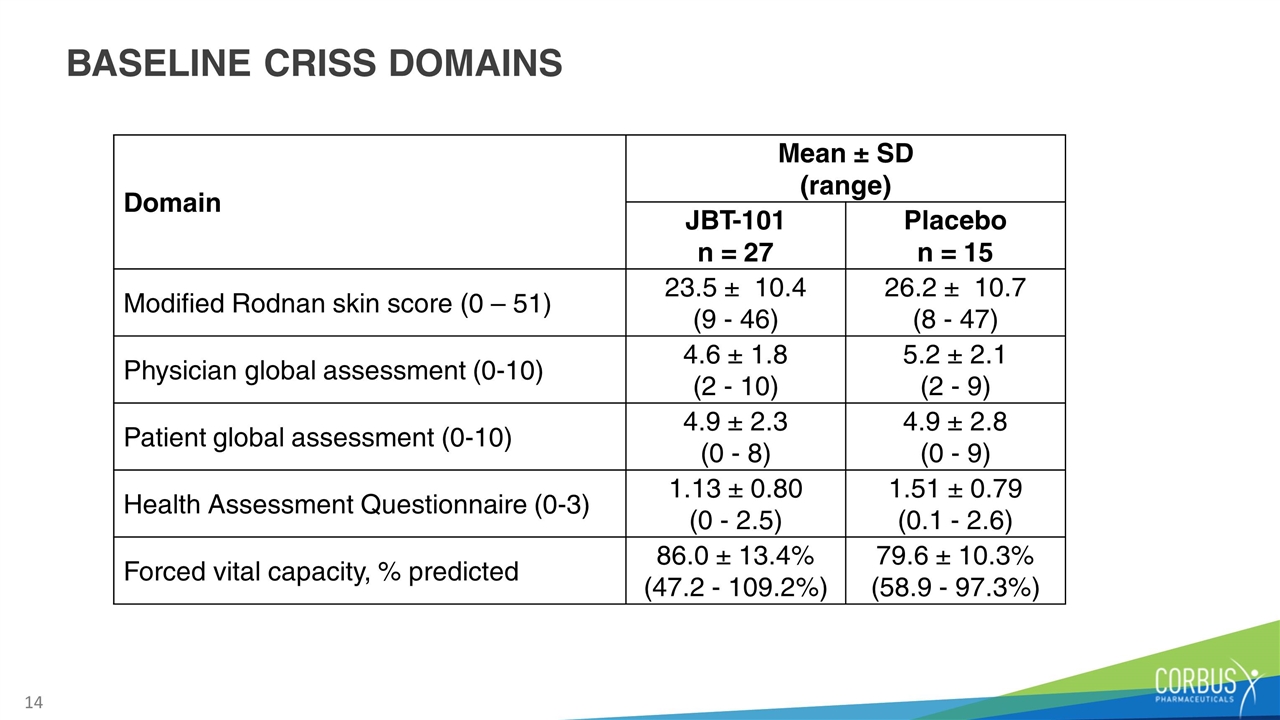
BASELINE CRISS DOMAINS Domain Mean ± SD (range) JBT-101 n = 27 Placebo n = 15 Modified Rodnan skin score (0 – 51) 23.5 ± 10.4 (9 - 46) 26.2 ± 10.7 (8 - 47) Physician global assessment (0-10) 4.6 ± 1.8 (2 - 10) 5.2 ± 2.1 (2 - 9) Patient global assessment (0-10) 4.9 ± 2.3 (0 - 8) 4.9 ± 2.8 (0 - 9) Health Assessment Questionnaire (0-3) 1.13 ± 0.80 (0 - 2.5) 1.51 ± 0.79 (0.1 - 2.6) Forced vital capacity, % predicted 86.0 ± 13.4% (47.2 - 109.2%) 79.6 ± 10.3% (58.9 - 97.3%)
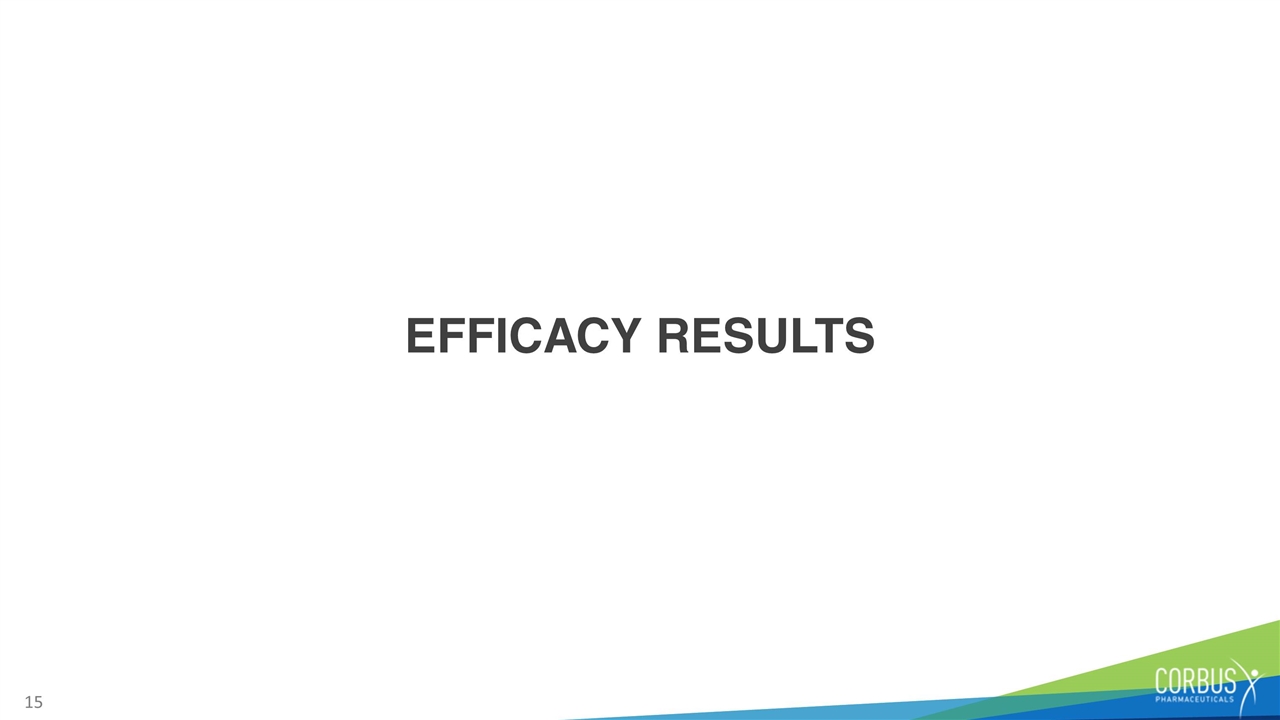
EFFICACY RESULTS
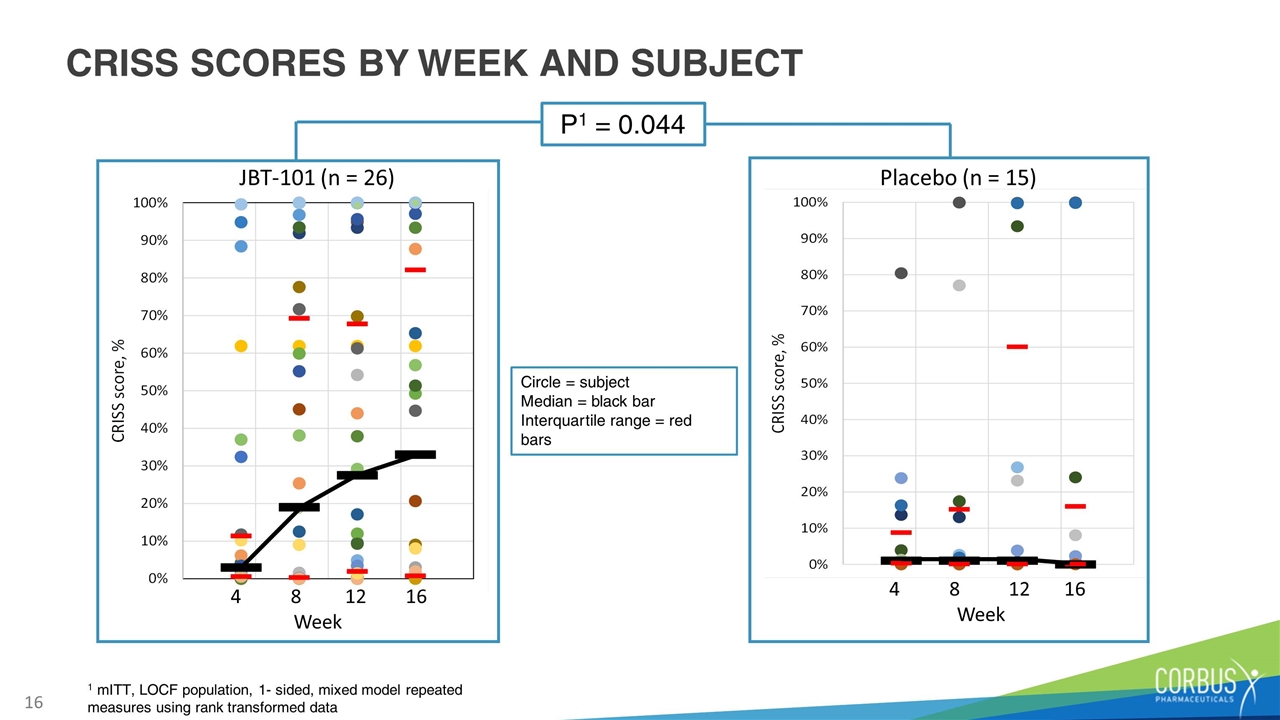
CRISS SCORES BY WEEK AND SUBJECT 1 mITT, LOCF population, 1- sided, mixed model repeated measures using rank transformed data 8 12 16 Week 8 12 16 Week JBT-101 (n = 26) Circle = subject Median = black bar Interquartile range = red bars P1 = 0.044 Placebo (n = 15)
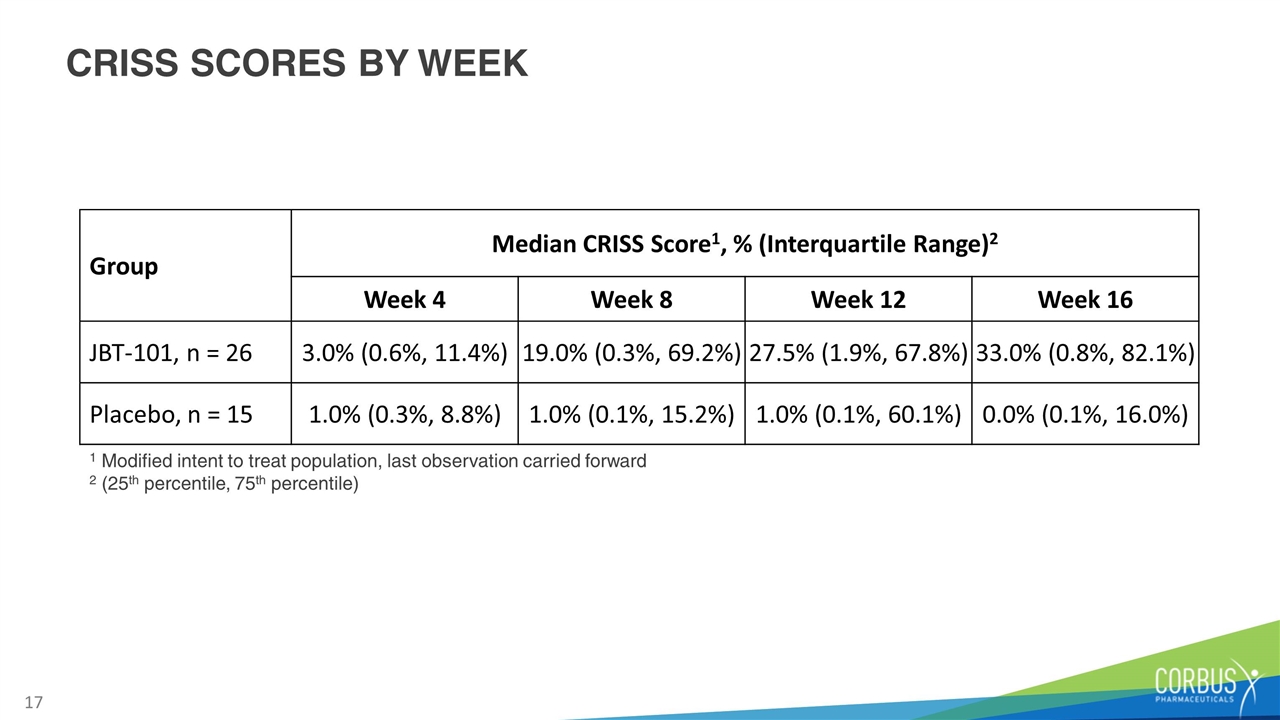
CRISS SCORES BY WEEK 1 Modified intent to treat population, last observation carried forward 2 (25th percentile, 75th percentile) Group Median CRISS Score1, % (Interquartile Range)2 Week 4 Week 8 Week 12 Week 16 JBT-101, n = 26 3.0% (0.6%, 11.4%) 19.0% (0.3%, 69.2%) 27.5% (1.9%, 67.8%) 33.0% (0.8%, 82.1%) Placebo, n = 15 1.0% (0.3%, 8.8%) 1.0% (0.1%, 15.2%) 1.0% (0.1%, 60.1%) 0.0% (0.1%, 16.0%)
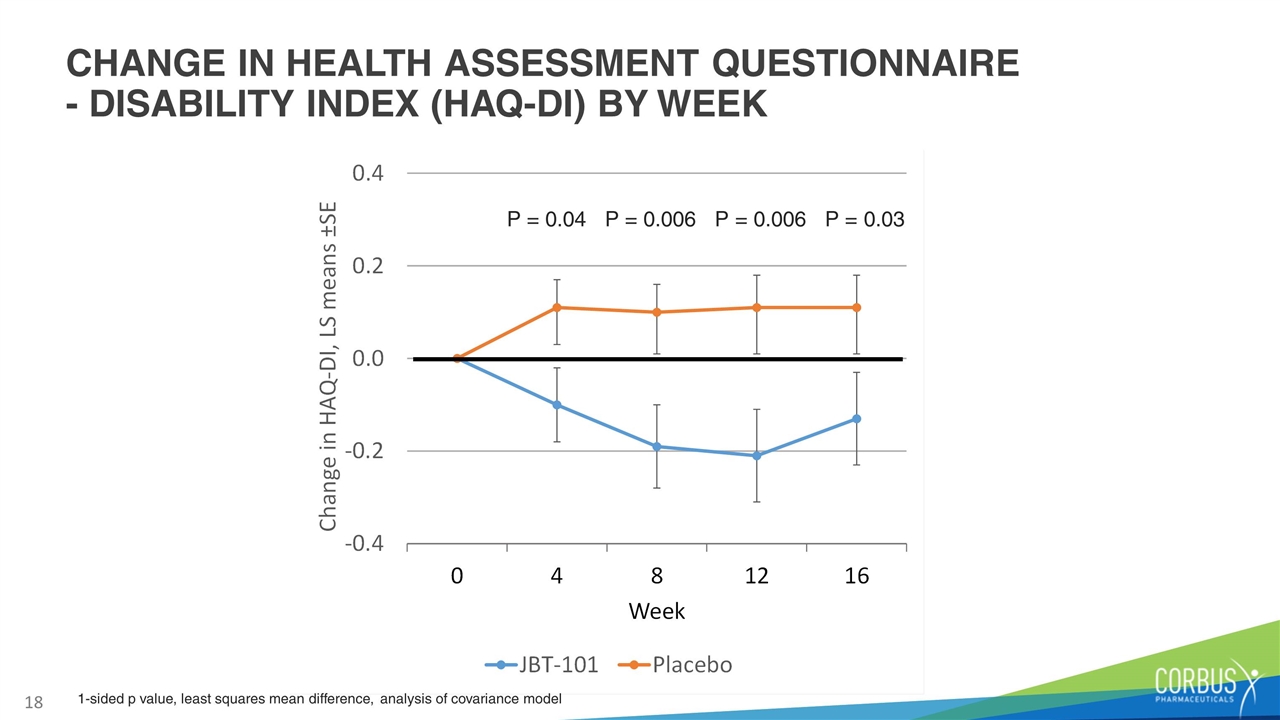
CHANGE IN HEALTH ASSESSMENT QUESTIONNAIRE - DISABILITY INDEX (HAQ-DI) BY WEEK P = 0.04 P = 0.006 P = 0.006 P = 0.03 1-sided p value, least squares mean difference, analysis of covariance model
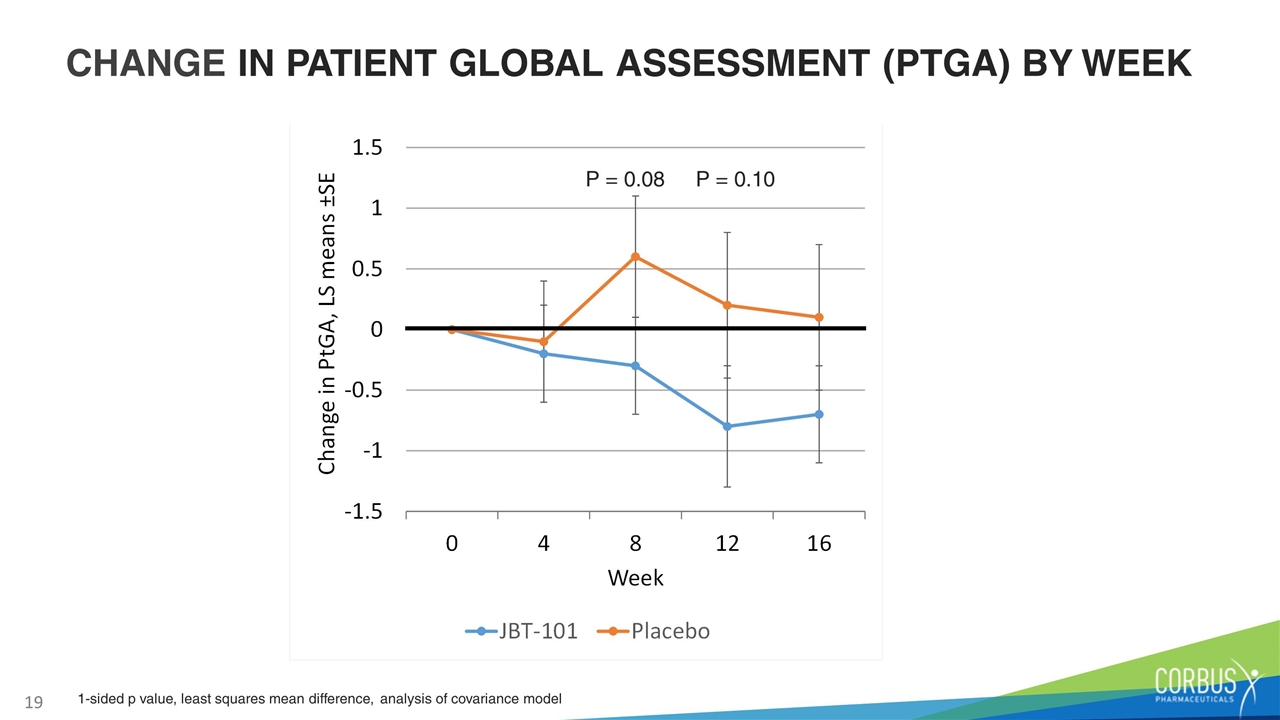
CHANGE IN PATIENT GLOBAL ASSESSMENT (PTGA) BY WEEK P = 0.08 P = 0.10 1-sided p value, least squares mean difference, analysis of covariance model
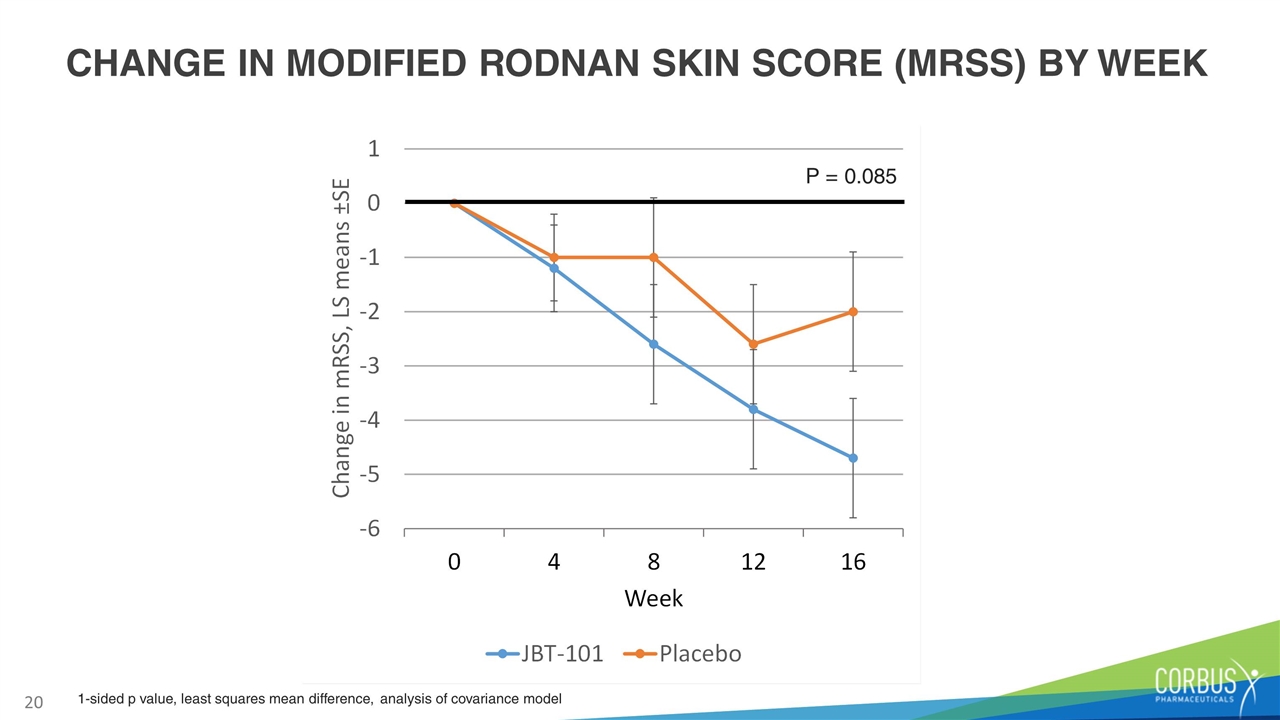
CHANGE IN MODIFIED RODNAN SKIN SCORE (MRSS) BY WEEK P = 0.085 1-sided p value, least squares mean difference, analysis of covariance model
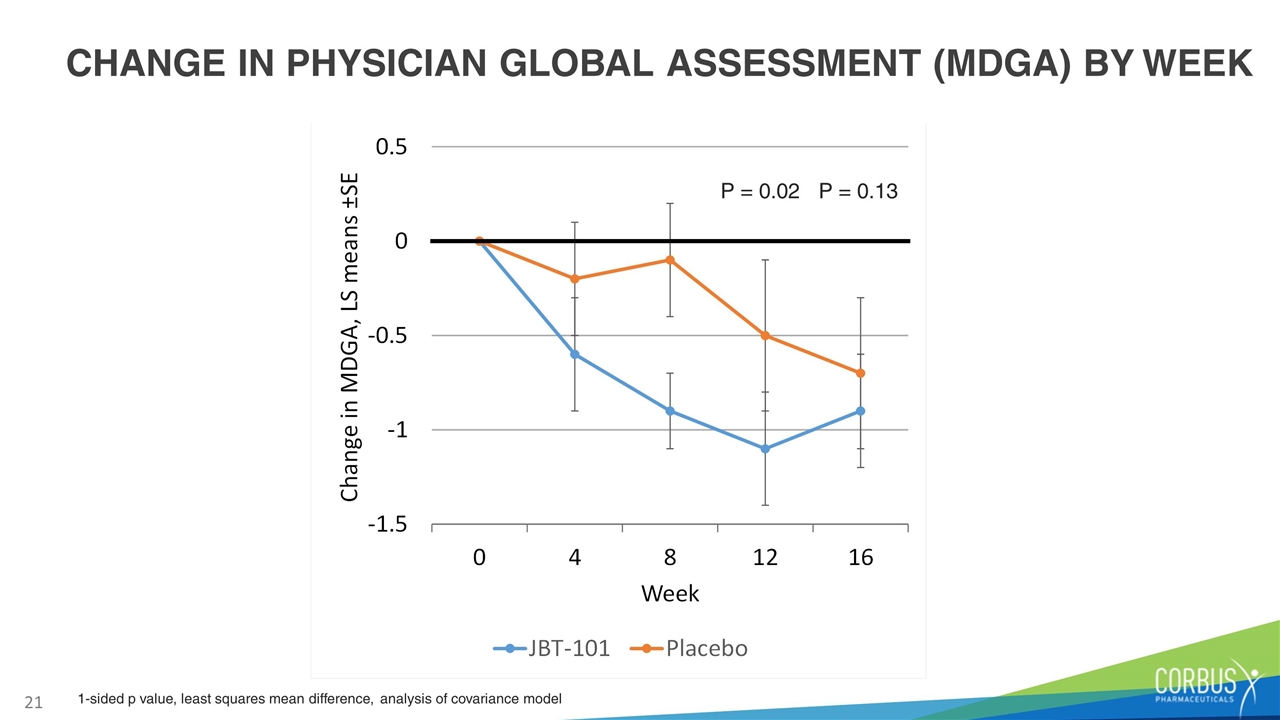
CHANGE IN PHYSICIAN GLOBAL ASSESSMENT (MDGA) BY WEEK P = 0.02 P = 0.13 1-sided p value, least squares mean difference, analysis of covariance model
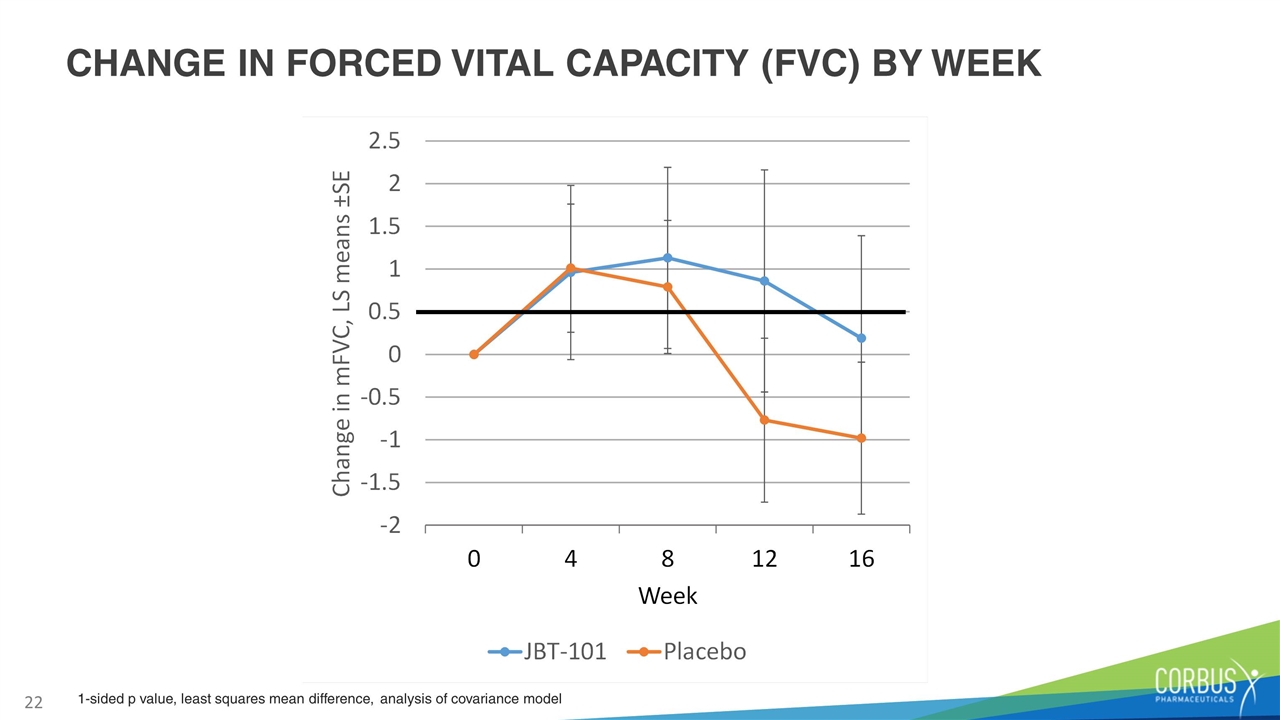
CHANGE IN FORCED VITAL CAPACITY (FVC) BY WEEK 1-sided p value, least squares mean difference, analysis of covariance model
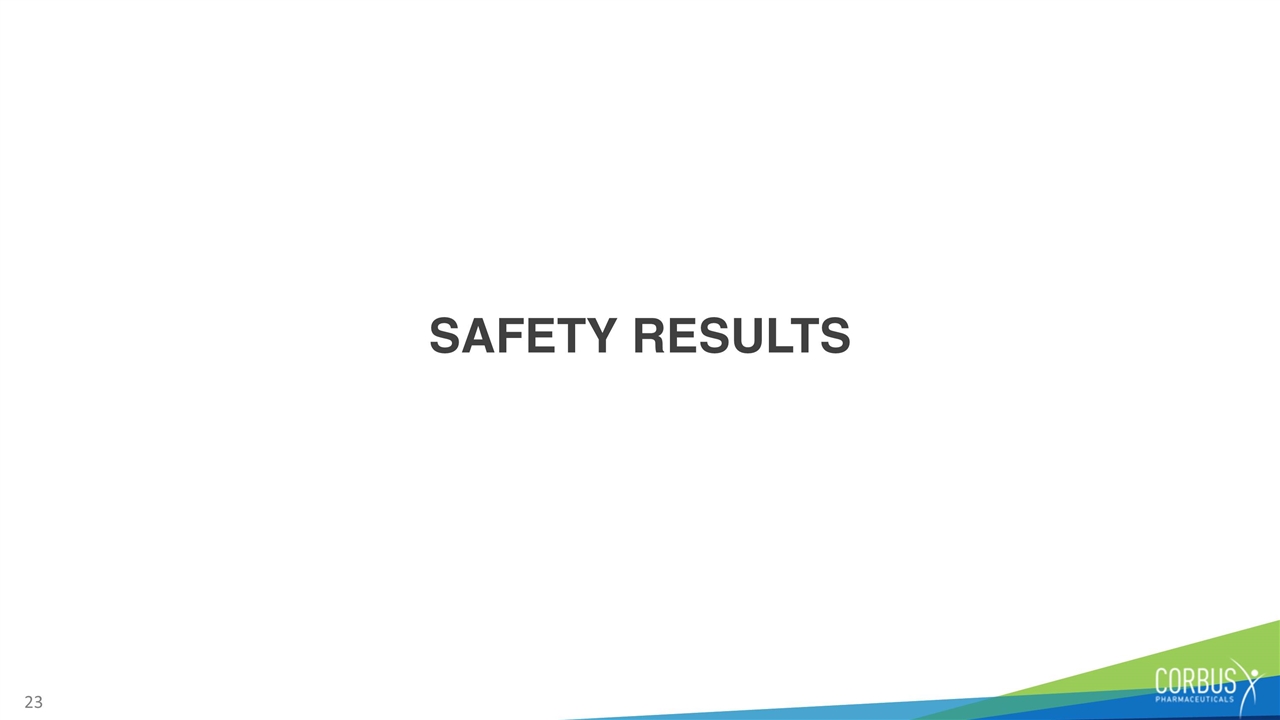
SAFETY RESULTS
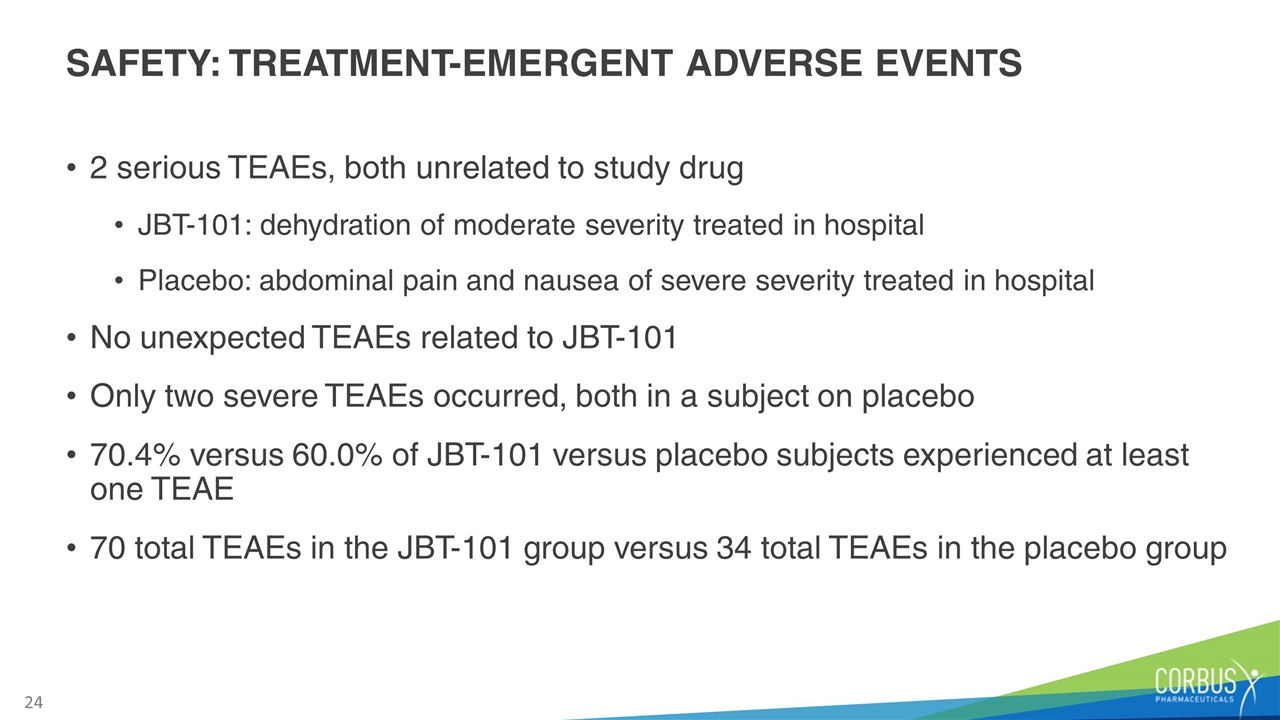
SAFETY: TREATMENT-EMERGENT ADVERSE EVENTS 2 serious TEAEs, both unrelated to study drug JBT-101: dehydration of moderate severity treated in hospital Placebo: abdominal pain and nausea of severe severity treated in hospital No unexpected TEAEs related to JBT-101 Only two severe TEAEs occurred, both in a subject on placebo 70.4% versus 60.0% of JBT-101 versus placebo subjects experienced at least one TEAE 70 total TEAEs in the JBT-101 group versus 34 total TEAEs in the placebo group
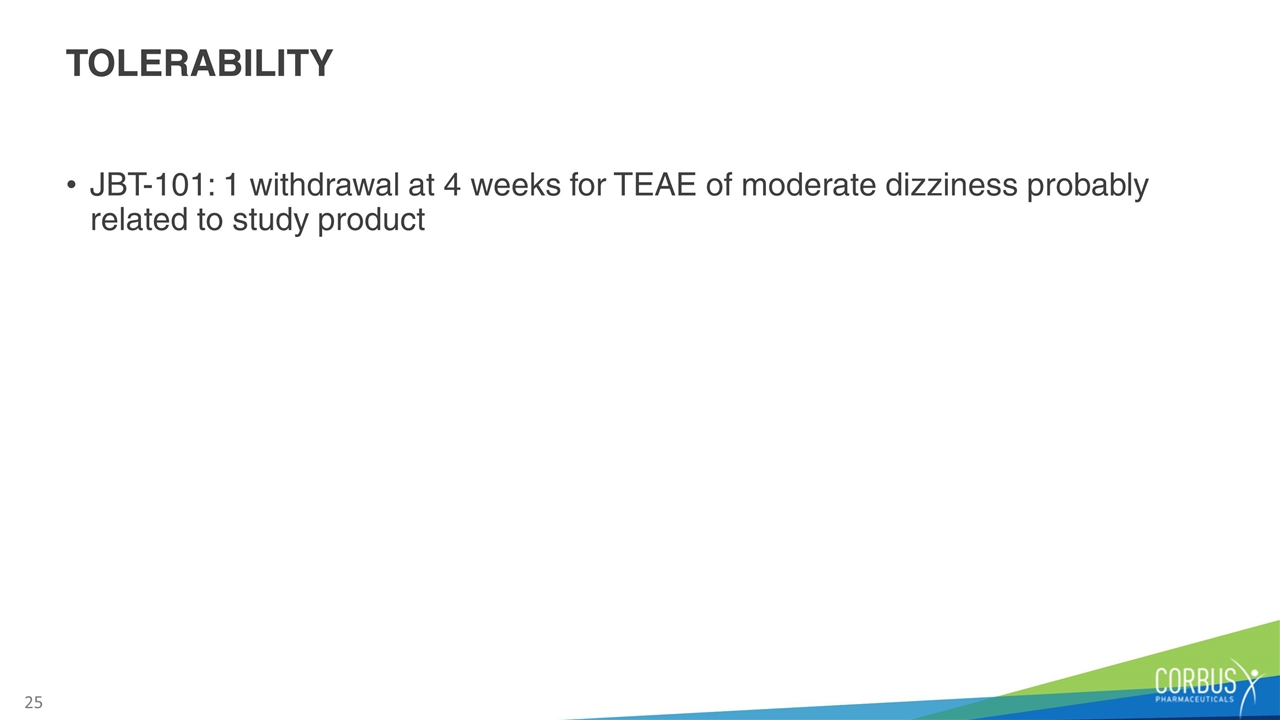
TOLERABILITY JBT-101: 1 withdrawal at 4 weeks for TEAE of moderate dizziness probably related to study product
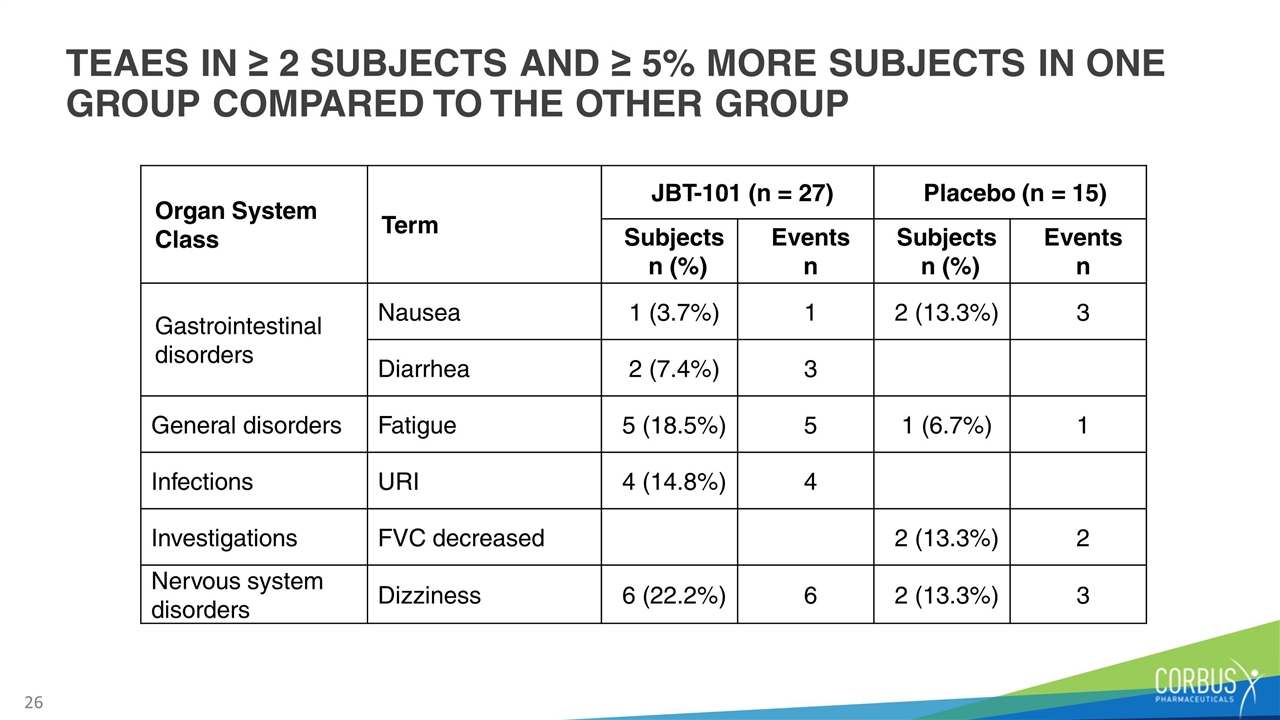
TEAES IN ≥ 2 SUBJECTS AND ≥ 5% MORE SUBJECTS IN ONE GROUP COMPARED TO THE OTHER GROUP Organ System Class Term JBT-101 (n = 27) Placebo (n = 15) Subjects n (%) Events n Subjects n (%) Events n Gastrointestinal disorders Nausea 1 (3.7%) 1 2 (13.3%) 3 Diarrhea 2 (7.4%) 3 General disorders Fatigue 5 (18.5%) 5 1 (6.7%) 1 Infections URI 4 (14.8%) 4 Investigations FVC decreased 2 (13.3%) 2 Nervous system disorders Dizziness 6 (22.2%) 6 2 (13.3%) 3
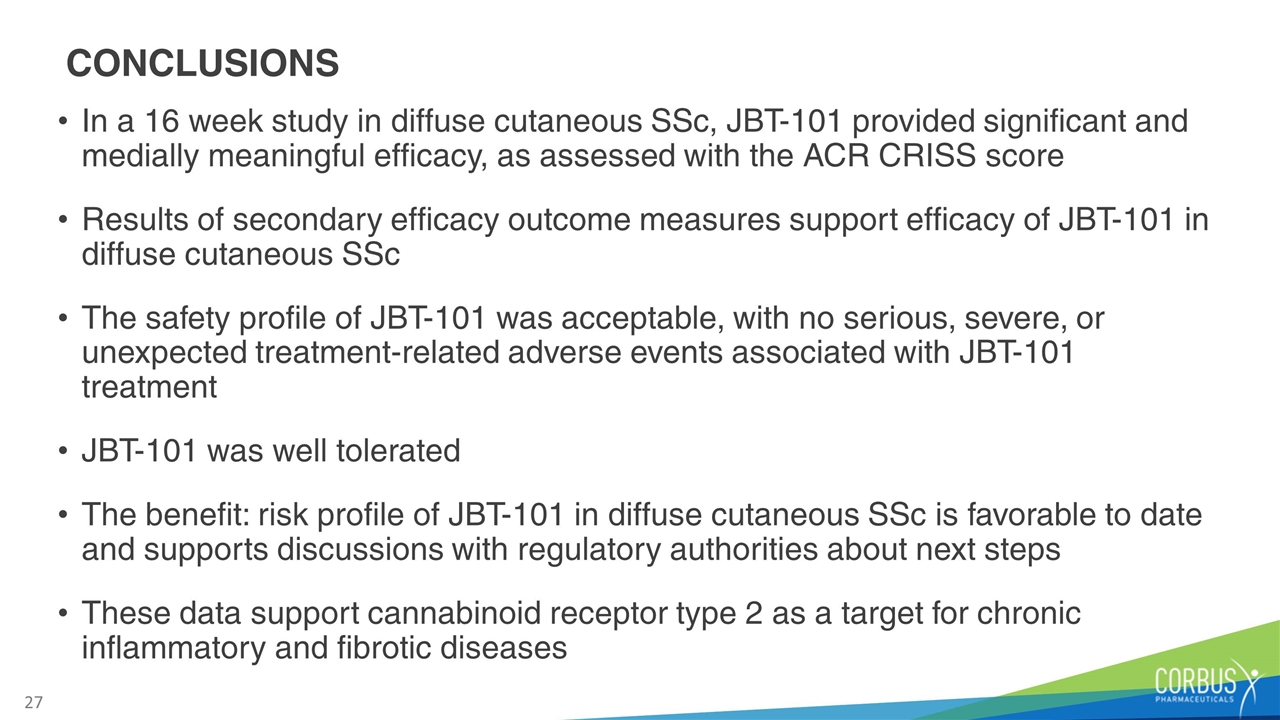
CONCLUSIONS In a 16 week study in diffuse cutaneous SSc, JBT-101 provided significant and medially meaningful efficacy, as assessed with the ACR CRISS score Results of secondary efficacy outcome measures support efficacy of JBT-101 in diffuse cutaneous SSc The safety profile of JBT-101 was acceptable, with no serious, severe, or unexpected treatment-related adverse events associated with JBT-101 treatment JBT-101 was well tolerated The benefit: risk profile of JBT-101 in diffuse cutaneous SSc is favorable to date and supports discussions with regulatory authorities about next steps These data support cannabinoid receptor type 2 as a target for chronic inflammatory and fibrotic diseases
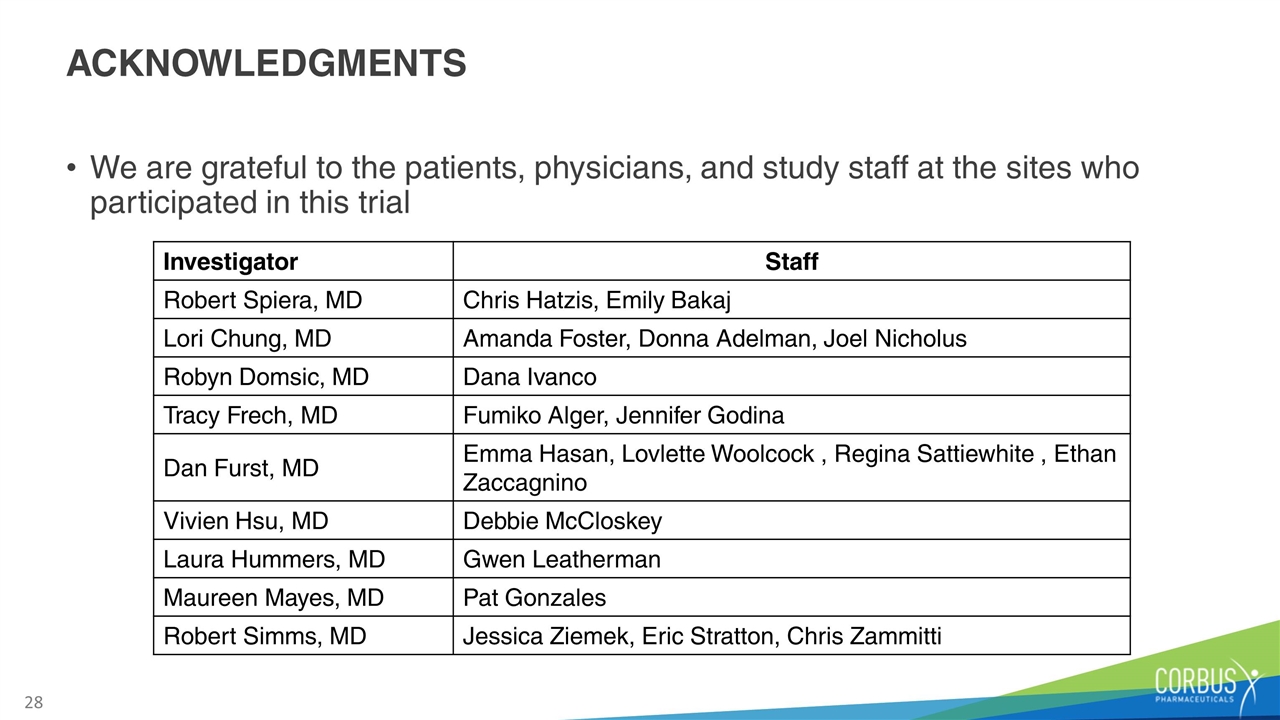
ACKNOWLEDGMENTS We are grateful to the patients, physicians, and study staff at the sites who participated in this trial Investigator Staff Robert Spiera, MD Chris Hatzis, Emily Bakaj Lori Chung, MD Amanda Foster, Donna Adelman, Joel Nicholus Robyn Domsic, MD Dana Ivanco Tracy Frech, MD Fumiko Alger, Jennifer Godina Dan Furst, MD Emma Hasan, Lovlette Woolcock , Regina Sattiewhite , Ethan Zaccagnino Vivien Hsu, MD Debbie McCloskey Laura Hummers, MD Gwen Leatherman Maureen Mayes, MD Pat Gonzales Robert Simms, MD Jessica Ziemek, Eric Stratton, Chris Zammitti

COMMENTS
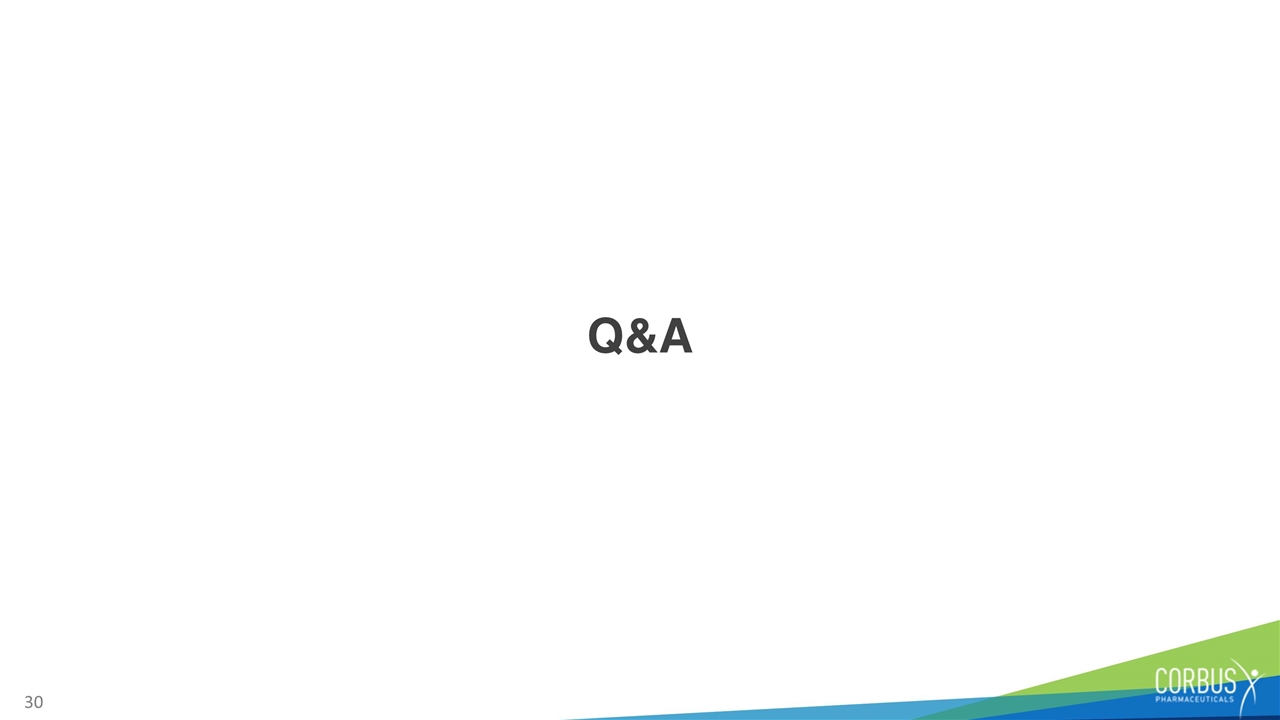
Q&A
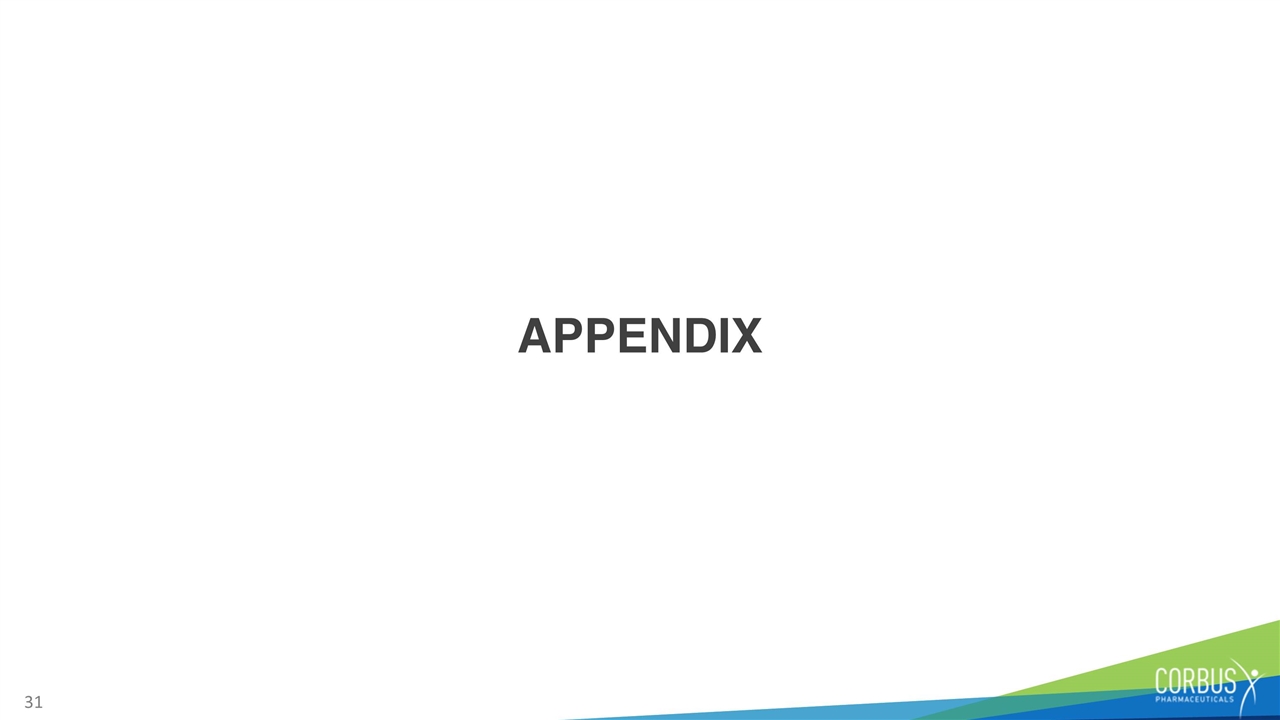
APPENDIX
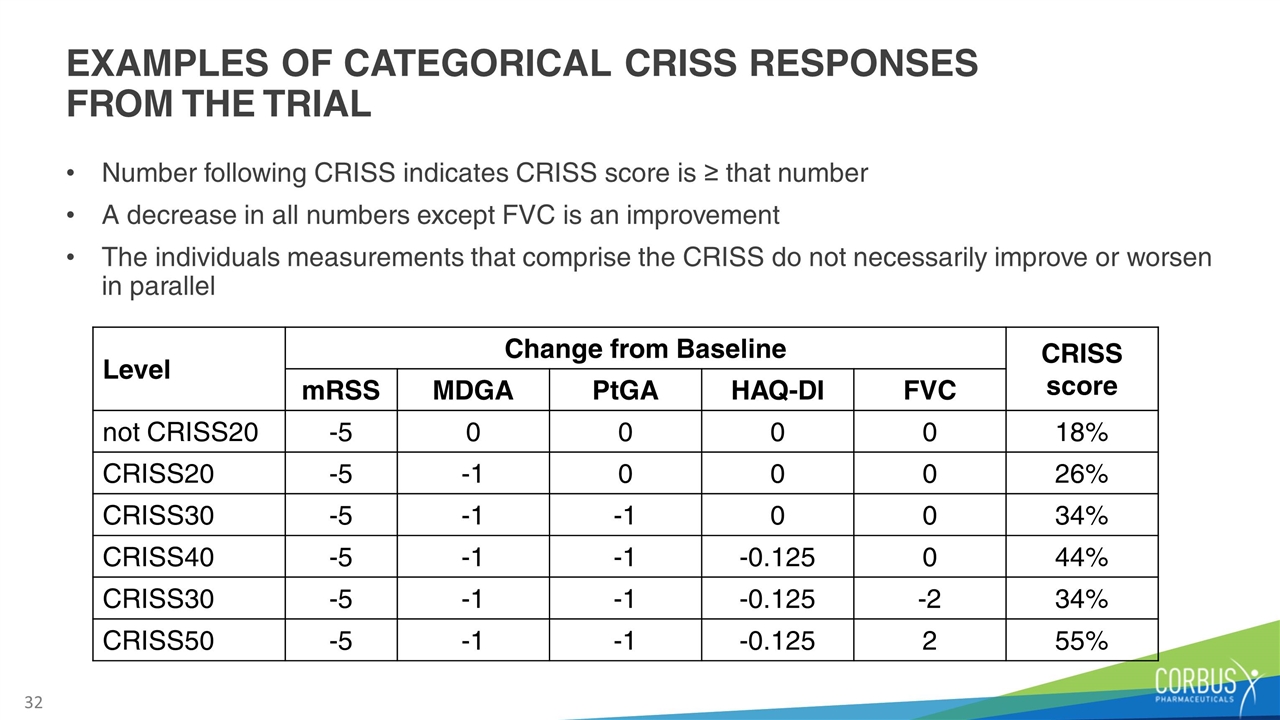
EXAMPLES OF CATEGORICAL CRISS RESPONSES FROM THE TRIAL Number following CRISS indicates CRISS score is ≥ that number A decrease in all numbers except FVC is an improvement The individuals measurements that comprise the CRISS do not necessarily improve or worsen in parallel Level Change from Baseline CRISS score mRSS MDGA PtGA HAQ-DI FVC not CRISS20 -5 0 0 0 0 18% CRISS20 -5 -1 0 0 0 26% CRISS30 -5 -1 -1 0 0 34% CRISS40 -5 -1 -1 -0.125 0 44% CRISS30 -5 -1 -1 -0.125 -2 34% CRISS50 -5 -1 -1 -0.125 2 55%
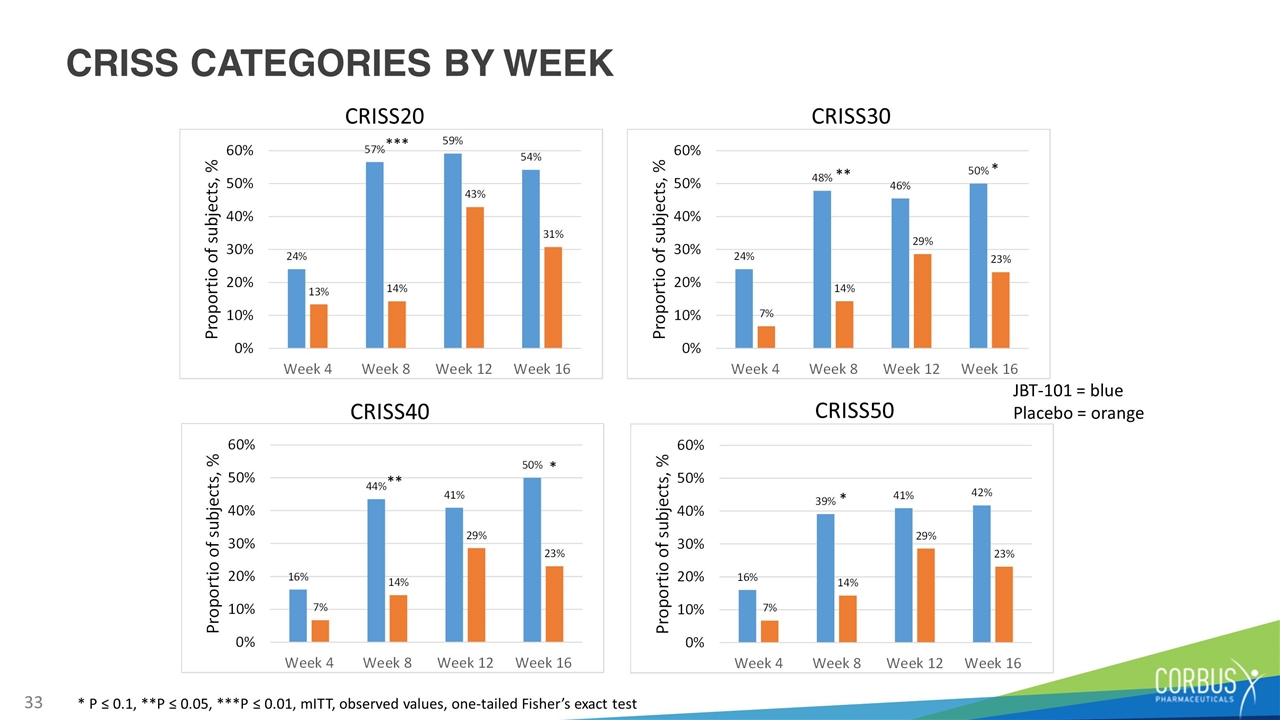
CRISS CATEGORIES BY WEEK *** CRISS20 CRISS40 * P ≤ 0.1, **P ≤ 0.05, ***P ≤ 0.01, mITT, observed values, one-tailed Fisher’s exact test JBT-101 = blue Placebo = orange CRISS30 CRISS50 ** * * ** *
































